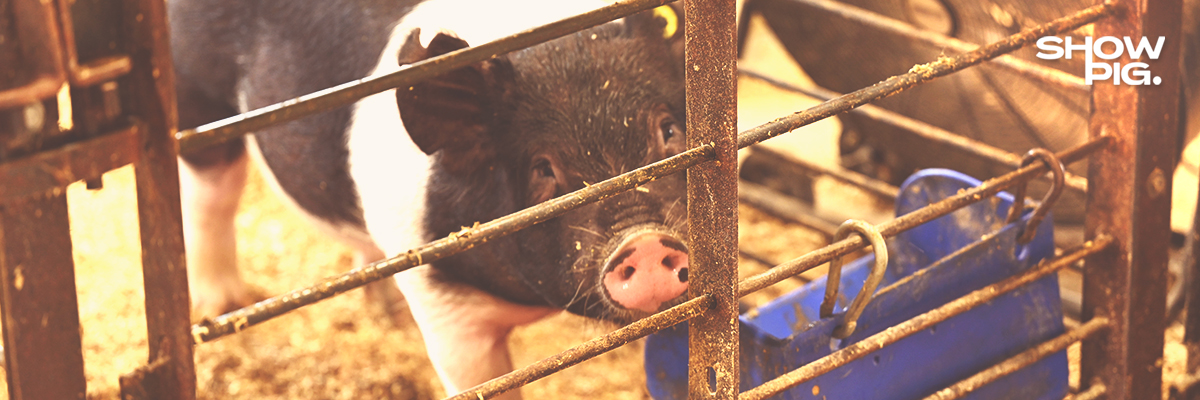

In Feeding Showpigs 102, we discussed the six essential nutrients your pig needs to survive and function. But once your pig’s basic requirements are met, how do you make adjustments to key nutrients that translate to improved performance and show composition?
There are three nutrient categories that inflict the most change when it comes to a showpig diet; crude protein, crude fat and crude fiber. By focusing on and altering these three nutrients through complete feed selection and supplementation, one can help fine tune their showpig to hit the ring on the right foot come their target show. In this next installment of the Feeding Showpigs series, we will take a closer look at what crude protein, fat and fiber do and how they can be added or adjusted through the feeding cycle to achieve your desired goals. Let’s get started!
ASSESS WHAT NEEDS CHANGED, BEFORE MAKING A CHANGE
After your pig has made it home and adapted to their new living environment, it is time to make adjustments and fine tune your feeding program to properly target your end point show. A good rule of thumb before making adjustments to your complete feed or supplements is to do a physical evaluation of your pig, to better determine what your pig needs. This should start with a trip to the scale to assess how much your pig weighs and what their rate of growth is. This can help you determine how much your pig will need to eat and gain daily to reach the correct weight bracket at their target show. Weight of your pig should be evaluated alongside maturity and composition to help make the best decision when changing feed. For example, a long bodied, lean, average muscled pig may weigh close to the same as a more moderately sized, heavy muscled pig, but both will have to be fed very differently to reach desired end points. We will get into those specific differences in feeding strategy in the next section on crude protein!
CRUDE PROTEIN FOR MUSCLE DEVELOPMENT
In the early stages of feeding, muscle development and growth are key. The most important nutrient to help with healthy muscle development is protein. As mentioned in Feeding Showpigs 102, pigs have NO true requirement for crude protein, but rather for individual amino acids. Amino acids are the building blocks that make up crude protein, and of the essential amino acids in the diet, lysine is the most limiting amino acid for swine, or the one that we use as the highest priority in swine diets. When selecting a complete show pig feed or identifying if additional protein supplements are needed, looking at the crude protein or lysine levels on the tag and pairing the right level with the weight, composition and maturity level of your pig is the best place to start. As a general rule of thumb, most feed lines offer crude protein diets ranging from 20 to 10%. Often a protein level of 20% is typically fed to pigs weighing 25-50 lbs; 18% or 16% is typically fed to pigs weighing 50-125 lbs; and a range from 18 to 10% for pigs weighing 125 to 290 lbs depending on their body composition and growth needs
However, you’ll remember that we mentioned weight isn’t the only physical identifier that dictates feed or protein changes – animal composition matters too. Depending on the muscle mass and maturity of your pig, the crude protein level of the feed you should select may vary. For example, if your pig is very heavy muscled at an early age, feeding a lower protein diet would be recommended, to ensure your pigs structure will be maintained to their target show. Feeding a lower protein diet helps slow the growth and lean muscle development of the pig because the feed is typically at or just below the daily amino acid requirement. On the other hand, if you have a pig that is lacking muscle or has excess fat at an early age, a higher crude protein feed can help enhance muscle growth and shape as well as slow down the development of excess fat.
Slight alterations in the protein level can make a big difference in a short amount of time when it comes to your pig’s development and muscle composition. Most of the time, these changes in crude protein levels can be made early on in the feeding process by selecting a complete feed that has the desired crude protein level. However, in some situations, additional supplementation may be added to increase crude protein levels. One supplementation option to increase crude protein levels is to add more soybean meal. While every complete showpig feed includes soybean meal, adding just 2.5% more soybean meal as a percentage of your feed can increase the crude protein level in the diet by 1%. For example, if you were to mix a 20 lb pail of complete 16% CP showpig feed with 0.5 lbs of soybean meal, your feed would actually be 17% crude protein. If adding more soybean meal is not a feasible mixing option, either purchasing the correct protein level or adding a show protein supplement on the market can be done.
Crude protein is critical to pay attention to when evaluating a feed tag and selecting a complete feed, particularly in the development stages of your showpig. While there can be a lot of different complete feed and supplement options on the market to meet desired crude protein levels, a general rule of thumb to keep in mind is the higher the percentage of crude protein, the more lean muscle your pig is going to put on. Use this basic concept to keep things simple. Assess the muscle composition and growth pattern of your pig, and decipher if more or less muscle development is needed, and this will guide your direction on crude protein level selection as you make an adjustment to complete feeds and supplements.
CRUDE FAT FOR ENERGY AND FLESH
Fat in the show pig diet is necessary for calories (energy), growth and fleshing. However, it is something to closely monitor as you start your pig on feed. Too much fat early on can lead to an overly-fleshy pig that may look plain by their end point. As a general rule of thumb, most complete feeds should land somewhere between 3.5 and 6.5% crude fat. Most corn based diets contain about 3.5% fat. If a complete feed reads with a higher percentage of fat in the diet, it can be assumed that additional fat sources were added to the complete feed ration.
Most pig’s dietary fat need will level off as they get to heavier weights and more maturity. However, in some cases, fine tuning for a show may require increased fat sources to promote extra flesh. At some point, you may have heard a judge or feeder make the comment, “they need more center body flesh or chub.” This is where crude fat in the diet may come into play. Increasing fat levels may be accomplished by making an adjustment to your complete feed, however more times than not, fat supplements are employed to help show pigs get some extra flesh prior to show day. There are several show fat supplements on the market that fall into two different categories: liquid and dry. While both types of supplements work to the same end result, liquid fat helps to improve the palatability of your pigs feed by providing more texture; an additional benefit to keep in mind when selecting the fat supplement you’d like to use. To determine fat supplement inclusion level, it is important to understand that adding 1.0% more fat, as a percentage of the feed, will increase total diet fat by 1%. To use a similar example to crude protein, if you have a 20 lb pail of feed, and add 0.2 lbs of fat, your 5% crude fat feed is now 6%.
CRUDE FIBER FOR FILL AND HOLDING
If you read Feeding Showpigs 102, you’ll recall that fiber was not an essential nutrient listed for show pigs. However, it plays an important role, typically near the end of the feeding period, to get your show pig ring ready! Crude fiber is a low energy feed source that is often used to add depth of body or fill to a showpig. A few common sources of crude fiber include soy hulls (34% CF), beet pulp (18% CF), wheat bran (8-11% CF), and whole or steam rolled oats (12% CF).
Another common use of crude fiber is leveraged at the end of the feeding period, when a showpig requires a “hold” ration to maintain a certain weight. When using a holding strategy, you are simply reducing the energy intake of the pig by reducing total complete feed consumption. Oftentimes this reduction in the complete feed can result in your pig becoming more aggressive, and that’s where fiber sources can come into play. Supplementing with low energy ingredients, such as soy hulls, beet pulp, or whole oat products can increase the amount that you feed each day while still maintaining a low level of energy intake. Keep in mind that steamed oat groats are not an ideal fiber source for holding due to the additional energy they provide. More energy means more growth, which is not the target intent for a crude fiber addition to the diet.
CONCLUSION
The CRUDE reality of feeding show pigs is it takes time to master the necessary adjustments to achieve optimal results. Start by focusing on these three nutritional categories, understand your pig and what they need, and ask questions. Over time the changes will come second nature, and almost routine! If you have questions though, we are here for that too! Head on over to the Forum to ask questions and get answers!
For a more in depth look at various feeding strategies and weight management, join us for our next blog, Feeding Showpigs 104!




















